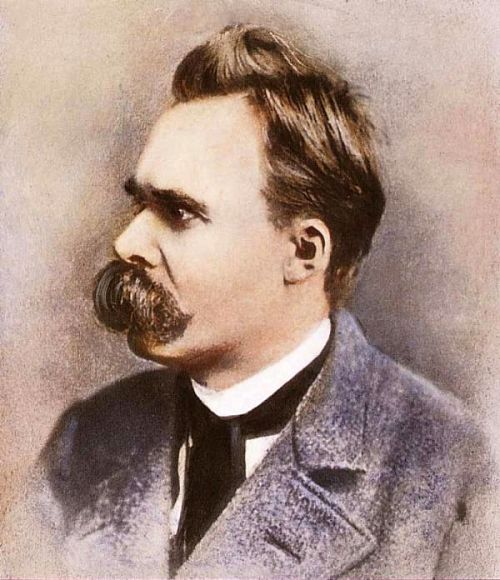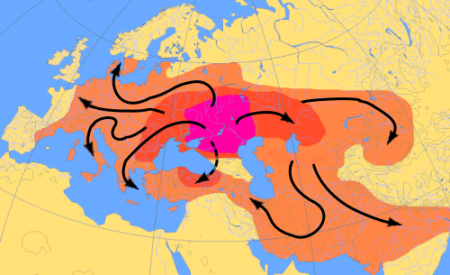The following is my abridgement of chapter 22 of William Pierce’s history of the white race, Who We Are:
Centuries of Colonialism Yield Benefits, Perils
Nearly All Black Slaves Went to Iberian America
Economic Colonialism Is Racial Treason

With the close of the Viking Age in the latter half of the 11th century, we left the prehistoric period, with all its pagan vigor, behind us in the previous installment and entered an era described more or less fully by contemporary written accounts. Our aim here, in accord with the purpose of this entire series, is to select from the wealth of historical material covering the events of the last 900 years that which is especially pertinent to racial developments, rather than to political, religious, economic, artistic, scientific, or other cultural aspects of life—keeping always in mind, of course, that, in the final analysis, race and culture are inseparable.
We have already noted, however briefly, the racial developments in Iberia through the 15th century (installment 19) and in Eastern Europe through the 17th century (installment 20). Most of what follows will be concerned with the North and the West of Europe: more specifically, with the people of that region and their expansion over the globe.
♣
For five centuries after the abandonment of the settlements in North America, Europe staggered along under the burden of a number of problems: battling Moors, Turks, and Mongols on its southern and eastern frontiers and often well inside those frontiers; yielding up the last of its spiritual and mental freedom and settling into a straitjacket of superstition and orthodoxy, as the Christian Church tightened its grip on all of Europe; succumbing to the Black Death by the tens of millions, as this dread scourge swept over the land in the 14th century and killed every fourth European. In addition to these problems imported into Europe from Asia, the Europeans were no slouches at generating problems of their own, and territorial and dynastic warfare continued to take their toll throughout the Middle Ages.
By the beginning of the 15th century, however, the indomitable spirit of the White race was clearly making gains on several fronts: material, intellectual, and spiritual. On the first of these, European energy and inventiveness had kept up a slow but steady increase in productivity, both in agriculture and in the crafts, so that, despite the ravages of war and plague, the accumulation of wealth in all social strata had resulted in an average standard of living vastly higher than in any Asian land.
In the fifth decade of the century the German printer Johann Gutenberg of Mainz developed the process of printing with movable, metal type to the point that the mass production of books could be undertaken. For the first time in the life of the race the recording and general dissemination of man’s accumulated knowledge to all with the wit and the will to profit by it became a practical matter.
And it was only in Europe that this wit and will were manifested. Some of the earlier developments in the printing craft had come from Asia—ink and paper, for example—but the explosion in knowledge resulting from Gutenberg’s work was confined almost entirely to our own European ancestors. By the end of the 15th century 1,000 new titles per year were being produced by Europe’s book printers. By 1815 the number had climbed to 20,000 per year.
Even on the spiritual front there was progress. The Church, grown soft, corrupt, and overconfident in the centuries since the Saxons and the Vikings had been forced to the baptismal font, was spoiling for an upset by the end of the 15th century. It had laid the basis for its own downfall, and early in the following century its monopoly in matters of the spirit was dealt two lethal blows, first by Martin Luther in Germany (1517), and, a little over a decade later, by King Henry VIII in England. It is one of history’s sweetest ironies that Martin Luther was a Saxon and King Henry was the descendant of Norman Vikings.
Amerind Fate. The native Amerinds found by the Spaniards in the West Indies were, like those of the mainland, of Mongoloid derivation, being the descendants of Mongoloid peoples who had begun crossing the Bering Strait from Siberia to North America some 12,000 years ago and had then gradually propagated throughout the empty North and South American continents and the adjacent islands.
Since the Spaniards’ entire purpose in the New World was economic exploitation, not the propagation of their own race, they did not deliberately liquidate the native population. In some areas, however, that was the inadvertent effect of the Spanish conquest. The Indians were not constitutionally suited to the unremitting slave labor in the gold and silver mines and on the sugar plantations which was forced on them by their new masters, and they died like flies under the Spanish yoke.
An enormous toll was also taken by smallpox, a disease endemic among the Europeans but one to which the Amerinds, isolated as they had been for thousands of years, had no natural immunity. It virtually depopulated the Caribbean islands and then wreaked havoc among the mainland Indians. (The Indian revenge was syphilis, a New World disease entirely new to the Europeans—at least, in the new and virulent form in which it existed among the Amerinds.)
Beginning of the Black Tide. Because of the inadequacy of the Indians as a local labor force, the Spaniards almost immediately began importing Negro slaves from West Africa. The latter belong to a race ideally suited to the plantation labor of that era. The Blacks were first used in the West Indies, then on the Brazilian mainland. Approximately a million of them were imported in the period 1550-1650, and by the latter date they had completely replaced the Amerind natives as a slave labor force on the Caribbean islands.
Approximately 150,000 Spaniards and Portuguese had migrated to the New World by the middle of the 17th century, and natural increase had raised their number to about 400,000. They ruled over about 9,000,000 Indians—and a growing population of mestizos (Indian-White mixed breeds), Blacks, mulattos, and Indian-Black mixed breeds. Only on the island of Cuba was there anything approaching a truly White Spanish or Portuguese community.
Northerners Arrive. From the beginning of the 17th century, however, Northern Europeans—English, French, and Dutch—began seriously contesting the Iberians’ claims on the New World. By 1650 nearly 50,000 English (and a few thousand French and Dutch) immigrants were settled on Caribbean land wrested away from the Spaniards, and another 50,000 had landed in North America.
In sharp contrast to the Spanish and Portuguese colonists, the great bulk of the Northern Europeans came to the New World not to exploit non-White labor and make money, but to settle and work the land themselves, in all-White communities. Thus, colonialism acquired two quite distinct meanings in the 17th and 18th centuries: a strictly economic meaning, which applied to all the Southern European and some of the Northern European colonies; and a racial meaning, which applied almost exclusively to the colonies of the Northerners.
The tropical climate of the Caribbean did not treat the Northerners as well as it did the Southern Europeans, however, and about half of those who settled there were killed off by fever. After reaching a total of around 100,000 by 1700, most of them moved on to North America. The ones who remained switched to Iberian-style colonialism and began importing Blacks to work Caribbean sugar plantations in much greater numbers than the Spanish and Portuguese had.
The Pollution of the South. During the 18th century nearly three million Black slaves were brought into the Caribbean by the English. Another three million were imported by the Iberians, the great majority of them going to Brazil. This established an overwhelmingly non-White population base for the Central and South American area.
It was only in the 19th century that this bleak racial picture for Latin America began to change, and then only in the southernmost part of the region, the consequence of a large influx of new European immigrants (most of them from Southern Europe) into an area which had previously had a very sparse Amerind population and had not been considered suitable for economic exploitation with Black labor by the early Spanish and Portuguese colonists. Today the only countries in South America which are substantially White are Uruguay (nearly 100 per cent), Argentina (between 80 and 90 per cent), and Chile (approximately 50 per cent).
Of the 9.5 million Negroes imported in the three centuries between 1550 and 1850, 4.25 million went to Brazil and other parts of northern South America, and 4.5 million went to the Caribbean and Central America. Another quarter of a million went to southern South America, and only half a million went to the southernmost colonies of North America.
As mentioned above, most of the Northern Europeans who came to the New World had quite different motives than did the Spanish and Portuguese. Most of the latter came only to make money, and relatively few brought their women with them; from the beginning miscegenation was common in the areas controlled by the Iberians.
The Northerners, on the other hand, came for the land and the opportunity for a new life on a new frontier. They brought their women and their plows with them, and for the most part, they did their own labor. They saw in the Indians no opportunity for economic exploitation, but only a danger to their families. Until missionaries began making Christians of the Indians and taking their side against the Whites, the latter just pushed them aside, took their land, and formed all-White communities of farmers, craftsmen, and tradesmen, as they had in Europe.
Colonization elsewhere
In Australia the Europeans (nearly all British) encountered an extremely primitive native race—in some features even more primitive than the Negro—numbering around a quarter of a million. Disease and deliberate liquidation by the Europeans had reduced the Australian aborigines to about 60,000 by the beginning of this century. Even today, under protection from the Australian government, they have recovered to only 80,000 and remain largely isolated from the predominantly Northern European population of 13 million.
In New Zealand the non-White native population was less primitive, being of Polynesian stock. The European settlers reduced the number of these Polynesians (Maoris) from an initial 250,000 to about 40,000 at the beginning of this century. Since then a misguided White policy of deliberate coddling has resulted in a population explosion back up to the quarter-million mark. Today, among a White New Zealand population of only three million, the still-expanding Maori minority, mostly urbanized, poses a growing racial threat.
England in India. First the Portuguese, then in succession the Spanish, the Dutch, the English, the Danes, the French, and the Austrians attempted to control the trade between Europe and India. In every case the motivation was strictly economic, not racial.
Although the long English experience in India had a profound influence on the national psyche of England, it provided no net benefits to the White race. The soldierly spirit of duty and uncomplaining self-sacrifice in the service of one’s kind eventually was perverted into a maudlin sense of obligation to the conquered scum of the earth. Again it was Kipling who said it best:
Take up the White Man’s burden
Send forth the best ye breed
Go, bind your sons to exile
To serve your captives’ need;
To wait in heavy harness
On fluttered folk and wild
Your new-caught, sullen peoples,
Half-devil and half child….
Take up the White Man’s burden
And reap his old reward:
The blame of those ye better,
The hate of those ye guard.
The hard lessons learned on the plains of Afghanistan were soon forgotten. Too many years of ease intervened, and moral rot set in. When the Indians became restless again after the Second World War, superstition and moral softness kept the English from dealing with them as Robert Clive had. In the end, though colonialism in its day had made some Englishmen very rich, nothing was left except the superstition and the softness. And because of that superstition and softness, it is now the Indians and the other conquered races who are colonizing England without opposition from the English.
South Africa. The story of southern Africa is different, but equally instructive. Although the Portuguese first found it, they saw no economic opportunities there and did not colonize it.
It was, in the 15th century, an almost empty land, with only a few thousand yellow-skinned Bushmen eking out an existence there by hunting and gathering. The Negroes still had not emerged from their jungles, far to the north.
The Dutch established the first settlement in southern Africa in 1652, at the Cape of Good Hope, but its purpose was only to provide a way station for their maritime traffic between Europe and the East Indies. Five years later, however, the first Dutch farmers arrived and established farmsteads in the vicinity of the way station.
By 1671 Dutch colonists were expanding from the Cape Colony deep into the interior of southern Africa, driving herds of cattle and horses before them and building farms and villages as they went.
Mixed with the Dutch trekkers into the interior were an increasing number of German colonists. In 1688 a group of French Huguenot refugees from the anti-Protestant massacres of the Counter-Reformation arrived. From this group are descended the many South Africans of today bearing French names.
Although southern Africa had become a de facto racial colony by the beginning of the 18th century, it was still a de jure economic colony, under the control of the Dutch East India company. The Company, whose sole interest was profit, saw itself losing control of what had been intended to be only a provisioning facility for its ships on the way to and from the East Indies. Consequently, in 1707 it made the fateful decision to stop providing assistance to European families who wanted to settle in its African colony.
In 1717, guided by the same profit-oriented reasoning, it decided to import Black slaves rather than bring more White craftsmen and artisans into the colony to meet a labor shortage.
The consequence of these capitalist policies was that, when the Dutch East India Company finally disappeared from the scene in 1795, a century and a half after the arrival of the first settlers, there were still only 15,000 Whites in southern Africa. Furthermore, they had started down the deadly path of dependence on Black labor, rather than total White self-sufficiency.
The loss of homogeneity had far-reaching, negative results, which are still felt today. The final end for the Whites there can be, at most, a matter of two decades away.
The hard lesson taught by the different results of the European colonization of North America, Latin America, Australia, New Zealand, India, and southern Africa is that the only type of colonization with lasting significance is racial colonization; and that racial colonization can succeed only when Whites are willing and able to clear the land of non-White inhabitants and keep it clear.




